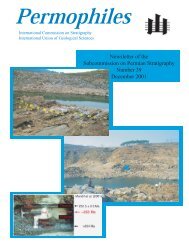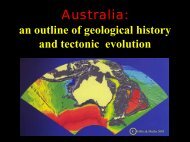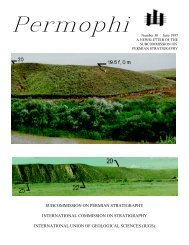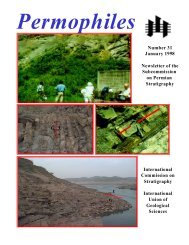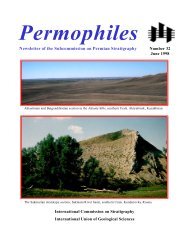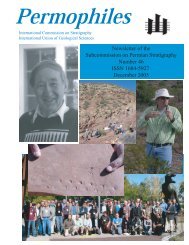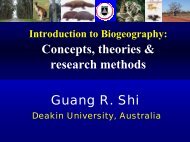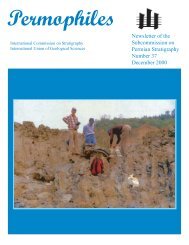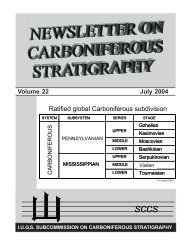Newsletter of the Subcommission on Permian Stratigraphy Number ...
Newsletter of the Subcommission on Permian Stratigraphy Number ...
Newsletter of the Subcommission on Permian Stratigraphy Number ...
Create successful ePaper yourself
Turn your PDF publications into a flip-book with our unique Google optimized e-Paper software.
zoic-Mesozoic transiti<strong>on</strong>. Wuhan, 1999.Sweet, W.C., Mei, S., 1999b. The <strong>Permian</strong> Lopingian and basalTrassic Sequence in Northwest Iran. Permophiles, 33: p. 14-18.Van Wag<strong>on</strong>er, J. C., Mitchum, R. M., Campi<strong>on</strong>, K. M. andRahmanian, V. D., 1990: Siliciclastic sequence stratigraphy inwell logs, cores and outcrops: c<strong>on</strong>cepts for high resoluti<strong>on</strong>correlati<strong>on</strong> <str<strong>on</strong>g>of</str<strong>on</strong>g> time and facies. AAPG. Methods in Explorati<strong>on</strong>,Series 7: 98 pp.Wang, Cheng-yuan, Wu, J., Zhu, T., 1998. <strong>Permian</strong> c<strong>on</strong>od<strong>on</strong>tsfrom <str<strong>on</strong>g>the</str<strong>on</strong>g> Penglaitan secti<strong>on</strong>, Laibin County, Guangxi, and<str<strong>on</strong>g>the</str<strong>on</strong>g> base <str<strong>on</strong>g>of</str<strong>on</strong>g> <str<strong>on</strong>g>the</str<strong>on</strong>g> Wuchiapingian Stage (Lopingian Series).Acta Micropalae<strong>on</strong>tologica Sinica, v. 15 (3), p. 225-236.Wang, Cheng-yuan, 1999. The base <str<strong>on</strong>g>of</str<strong>on</strong>g> <str<strong>on</strong>g>the</str<strong>on</strong>g> Lopingian Series –restudy <str<strong>on</strong>g>of</str<strong>on</strong>g> <str<strong>on</strong>g>the</str<strong>on</strong>g> Penglaitan secti<strong>on</strong>. Programme with Abstractsto <str<strong>on</strong>g>the</str<strong>on</strong>g> XIV Internati<strong>on</strong>al C<strong>on</strong>gress <strong>on</strong> <str<strong>on</strong>g>the</str<strong>on</strong>g> Carb<strong>on</strong>iferous-<strong>Permian</strong>,August 17-21, 1999, Calgary, Alberta, Canada, p. 152.Wang, Chengyuan, 2000, The base <str<strong>on</strong>g>of</str<strong>on</strong>g> <str<strong>on</strong>g>the</str<strong>on</strong>g> Lopingian series —Restudy <str<strong>on</strong>g>of</str<strong>on</strong>g> <str<strong>on</strong>g>the</str<strong>on</strong>g> Penglaitan Secti<strong>on</strong>: Acta Micropalae<strong>on</strong>tologicaSinica, vol. 17, no. 1, p. 1-17.Wang, Chengyuan, 2001. Re-discussi<strong>on</strong> <str<strong>on</strong>g>of</str<strong>on</strong>g> <str<strong>on</strong>g>the</str<strong>on</strong>g> base <str<strong>on</strong>g>of</str<strong>on</strong>g> <str<strong>on</strong>g>the</str<strong>on</strong>g>Lopingian Series. Permophiles, 38:Wang, W., Mei, S. L. and Jin Y. G., (in press). Evidence <str<strong>on</strong>g>of</str<strong>on</strong>g> isotopecarb<strong>on</strong> and str<strong>on</strong>tium around <str<strong>on</strong>g>the</str<strong>on</strong>g> Guadalupian-Lopingianboundary. Paleoworld.Wardlaw, B.R. & Mei, S.L., 1998a: A discussi<strong>on</strong> <str<strong>on</strong>g>of</str<strong>on</strong>g> <str<strong>on</strong>g>the</str<strong>on</strong>g> early reportedspecies <str<strong>on</strong>g>of</str<strong>on</strong>g> Clarkina (<strong>Permian</strong> c<strong>on</strong>od<strong>on</strong>ta) and <str<strong>on</strong>g>the</str<strong>on</strong>g> possibleorigin <str<strong>on</strong>g>of</str<strong>on</strong>g> <str<strong>on</strong>g>the</str<strong>on</strong>g> genus. Palaeoworld, 9: p. 33-52.Wardlaw, B.R. & Mei, S.L., 1998b: Clarkina (c<strong>on</strong>od<strong>on</strong>t) z<strong>on</strong>ati<strong>on</strong>for <str<strong>on</strong>g>the</str<strong>on</strong>g> Upper <strong>Permian</strong> <str<strong>on</strong>g>of</str<strong>on</strong>g> China. Permophiles, 31: p. 3-5.Permophiles Issue #38 2001New C<strong>on</strong>od<strong>on</strong>t Definiti<strong>on</strong>s at <str<strong>on</strong>g>the</str<strong>on</strong>g> Guadalupian-Lopingian BoundaryCharles Henders<strong>on</strong>Department <str<strong>on</strong>g>of</str<strong>on</strong>g> Geology and Geophysics, University <str<strong>on</strong>g>of</str<strong>on</strong>g> Calgary,Calgary, Alberta, CanadaBruce WardlawU.S. Geological Survey, MS970, Rest<strong>on</strong>, VA, USAShil<strong>on</strong>g MeiChina University <str<strong>on</strong>g>of</str<strong>on</strong>g> Geosciences, Beijing, China and University <str<strong>on</strong>g>of</str<strong>on</strong>g>CalgaryCh<strong>on</strong>gqun CaoNanjing Institute <str<strong>on</strong>g>of</str<strong>on</strong>g> Geology and Pale<strong>on</strong>tology, Nanjing, China210008Introducti<strong>on</strong>There has been c<strong>on</strong>siderable debate regarding <str<strong>on</strong>g>the</str<strong>on</strong>g> definiti<strong>on</strong>for <str<strong>on</strong>g>the</str<strong>on</strong>g> Guadalupian-Lopingian boundary GSSP. In this issue <str<strong>on</strong>g>of</str<strong>on</strong>g>Permophiles Jin et al. propose that two possible positi<strong>on</strong>s for <str<strong>on</strong>g>the</str<strong>on</strong>g>GSSP should be c<strong>on</strong>sidered. The first <str<strong>on</strong>g>of</str<strong>on</strong>g> <str<strong>on</strong>g>the</str<strong>on</strong>g>se is <str<strong>on</strong>g>the</str<strong>on</strong>g> FAD <str<strong>on</strong>g>of</str<strong>on</strong>g>Clarkina postbitteri in bed 6i upper at Penglaitan. This positi<strong>on</strong> isexcellent as it represents <str<strong>on</strong>g>the</str<strong>on</strong>g> first appearance <str<strong>on</strong>g>of</str<strong>on</strong>g> Clarkina anywherein China, although <str<strong>on</strong>g>the</str<strong>on</strong>g>re is a possibility that it is not <str<strong>on</strong>g>the</str<strong>on</strong>g> trueFAD <str<strong>on</strong>g>of</str<strong>on</strong>g> Clarkina. This positi<strong>on</strong> potentially represents a major evoluti<strong>on</strong>arychange within <str<strong>on</strong>g>the</str<strong>on</strong>g> c<strong>on</strong>od<strong>on</strong>t successi<strong>on</strong>. The problems<str<strong>on</strong>g>of</str<strong>on</strong>g> this point relate to <str<strong>on</strong>g>the</str<strong>on</strong>g> lack <str<strong>on</strong>g>of</str<strong>on</strong>g> c<strong>on</strong>sensus regarding <str<strong>on</strong>g>the</str<strong>on</strong>g> origin <str<strong>on</strong>g>of</str<strong>on</strong>g>Clarkina postbitteri and <str<strong>on</strong>g>the</str<strong>on</strong>g> fact that this introducti<strong>on</strong> is associatedwith a sequence boundary. However, at this locati<strong>on</strong> this po-35siti<strong>on</strong> represents <str<strong>on</strong>g>the</str<strong>on</strong>g> c<strong>on</strong>formable interval for <str<strong>on</strong>g>the</str<strong>on</strong>g> sequence boundaryand <str<strong>on</strong>g>the</str<strong>on</strong>g>refore any gap is very minor in durati<strong>on</strong> and <str<strong>on</strong>g>of</str<strong>on</strong>g> littlechr<strong>on</strong>ostratigraphic significance. The sec<strong>on</strong>d positi<strong>on</strong> is at a pointwithin <str<strong>on</strong>g>the</str<strong>on</strong>g> lineage <str<strong>on</strong>g>of</str<strong>on</strong>g> Clarkina postbitteri to C. dukouensis. Thispositi<strong>on</strong> necessitates <str<strong>on</strong>g>the</str<strong>on</strong>g> identificati<strong>on</strong> and descripti<strong>on</strong> <str<strong>on</strong>g>of</str<strong>on</strong>g> twosubspecies <str<strong>on</strong>g>of</str<strong>on</strong>g> C. postbitteri. The Lopingian Boundary WorkingGroup prefers <str<strong>on</strong>g>the</str<strong>on</strong>g> sec<strong>on</strong>d positi<strong>on</strong>. Although Permophiles doesnot normally accept descripti<strong>on</strong>s <str<strong>on</strong>g>of</str<strong>on</strong>g> new species/subspecies, weare making an excepti<strong>on</strong> by adding <str<strong>on</strong>g>the</str<strong>on</strong>g>se informal descripti<strong>on</strong>s sothat Permophiles readers can see that <str<strong>on</strong>g>the</str<strong>on</strong>g>re is a c<strong>on</strong>sensus. Thesetaxa have been formally described and will appear in <str<strong>on</strong>g>the</str<strong>on</strong>g> proceedingsvolume <str<strong>on</strong>g>of</str<strong>on</strong>g> <str<strong>on</strong>g>the</str<strong>on</strong>g> Internati<strong>on</strong>al C<strong>on</strong>gress <strong>on</strong> <str<strong>on</strong>g>the</str<strong>on</strong>g> Carb<strong>on</strong>iferousand <strong>Permian</strong> (Henders<strong>on</strong> and Mei, 2001).The tax<strong>on</strong>omy <str<strong>on</strong>g>of</str<strong>on</strong>g> <str<strong>on</strong>g>the</str<strong>on</strong>g>se neog<strong>on</strong>dolellids is revised to reflect<str<strong>on</strong>g>the</str<strong>on</strong>g> importance <str<strong>on</strong>g>of</str<strong>on</strong>g> morphologic characters like <str<strong>on</strong>g>the</str<strong>on</strong>g> carina in c<strong>on</strong>trastto previous descripti<strong>on</strong>s that emphasized <str<strong>on</strong>g>the</str<strong>on</strong>g> platform outline.The diagnoses presented here revise and improve up<strong>on</strong> previousdescripti<strong>on</strong>s. The evoluti<strong>on</strong> <str<strong>on</strong>g>of</str<strong>on</strong>g> Clarkina throughout <str<strong>on</strong>g>the</str<strong>on</strong>g>Lopingian is generally quite gradual. As a result, <str<strong>on</strong>g>the</str<strong>on</strong>g> descripti<strong>on</strong>smust c<strong>on</strong>sider <str<strong>on</strong>g>the</str<strong>on</strong>g> populati<strong>on</strong> as a whole and not isolated specimensor morphotypes. Wardlaw and Collins<strong>on</strong> (1979; p. 156) firstrecognized this problem when <str<strong>on</strong>g>the</str<strong>on</strong>g>y stated “that neog<strong>on</strong>dollelidspecies show much morphologic variability and <str<strong>on</strong>g>the</str<strong>on</strong>g>refore are difficultto classify. Rare individuals within a populati<strong>on</strong> may exhibit<strong>on</strong>e or several characteristics that are thought to be diagnostic <str<strong>on</strong>g>of</str<strong>on</strong>g>ano<str<strong>on</strong>g>the</str<strong>on</strong>g>r species. The analysis <str<strong>on</strong>g>of</str<strong>on</strong>g> large numbers <str<strong>on</strong>g>of</str<strong>on</strong>g> individuals and<str<strong>on</strong>g>the</str<strong>on</strong>g> use <str<strong>on</strong>g>of</str<strong>on</strong>g> several characters to define a species are necessary toresolve this problem.”Informal Tax<strong>on</strong>omic NotesClarkina dukouensis Mei and Wardlaw 1994aOriginal Diagnosis: A species <str<strong>on</strong>g>of</str<strong>on</strong>g> Clarkina characterized by a Paelement with a blunt, but rounded posterior platform terminati<strong>on</strong>;width <str<strong>on</strong>g>of</str<strong>on</strong>g> platform increasing gradually until <str<strong>on</strong>g>the</str<strong>on</strong>g> middle; cusp terminallylocated, erect and larger than <str<strong>on</strong>g>the</str<strong>on</strong>g> denticles <strong>on</strong> <str<strong>on</strong>g>the</str<strong>on</strong>g> posteriorhalf <str<strong>on</strong>g>of</str<strong>on</strong>g> <str<strong>on</strong>g>the</str<strong>on</strong>g> element; posteriormost denticle generally small;denticles increasing in size anteriorly (except <str<strong>on</strong>g>the</str<strong>on</strong>g> distal two smallerdenticles) and discrete posteriorly; furrows moderately developedand smooth; lateral margins slightly upturned at <str<strong>on</strong>g>the</str<strong>on</strong>g> widest point;platform narrowing sharply <strong>on</strong> <str<strong>on</strong>g>the</str<strong>on</strong>g> anterior half and c<strong>on</strong>tinuingnear <str<strong>on</strong>g>the</str<strong>on</strong>g> anterior end.Emended Comparis<strong>on</strong>:The changes between C. dukouensis and C. postbitteri are minorand gradual over a short interval, but <str<strong>on</strong>g>the</str<strong>on</strong>g> changes can be recognizedc<strong>on</strong>sistently within <str<strong>on</strong>g>the</str<strong>on</strong>g> typical parts <str<strong>on</strong>g>of</str<strong>on</strong>g> <str<strong>on</strong>g>the</str<strong>on</strong>g>ir range. In particular,<str<strong>on</strong>g>the</str<strong>on</strong>g> denticles <str<strong>on</strong>g>of</str<strong>on</strong>g> C. dukouensis are more closely spacedcompared to those <str<strong>on</strong>g>of</str<strong>on</strong>g> typical C. postbitteri. Clarkina dukouensisfirst appears at <str<strong>on</strong>g>the</str<strong>on</strong>g> Penglaitan secti<strong>on</strong> in bed 114-7e.Clarkina postbitteri Mei and Wardlaw 1994bOriginal Diagnosis: A species <str<strong>on</strong>g>of</str<strong>on</strong>g> Clarkina characterized by a Paelement that has a rounded posterior terminati<strong>on</strong>, a small brim, arelatively l<strong>on</strong>g and narrow platform that is widest in <str<strong>on</strong>g>the</str<strong>on</strong>g> anteriorhalf just posterior to <str<strong>on</strong>g>the</str<strong>on</strong>g> anterior narrowing where <str<strong>on</strong>g>the</str<strong>on</strong>g> platform ismildly upturned (except for some large forms which may be widestnear <str<strong>on</strong>g>the</str<strong>on</strong>g> posterior terminati<strong>on</strong>), posterior sides <str<strong>on</strong>g>of</str<strong>on</strong>g> platform areroughly parallel with a slight indentati<strong>on</strong> <strong>on</strong> <str<strong>on</strong>g>the</str<strong>on</strong>g> posterior innerside, a moderate cusp <str<strong>on</strong>g>of</str<strong>on</strong>g> circular to el<strong>on</strong>gate oval cross secti<strong>on</strong>,space between cusp and first posterior denticle is larger than anyo<str<strong>on</strong>g>the</str<strong>on</strong>g>r <strong>on</strong> <str<strong>on</strong>g>the</str<strong>on</strong>g> carina, first 3-4 denticles more widely spaced and less



